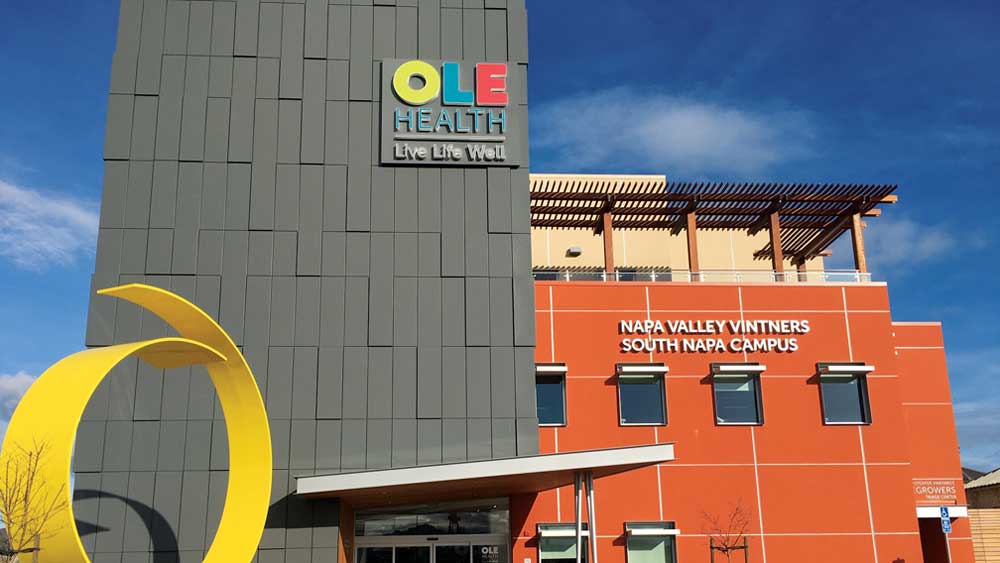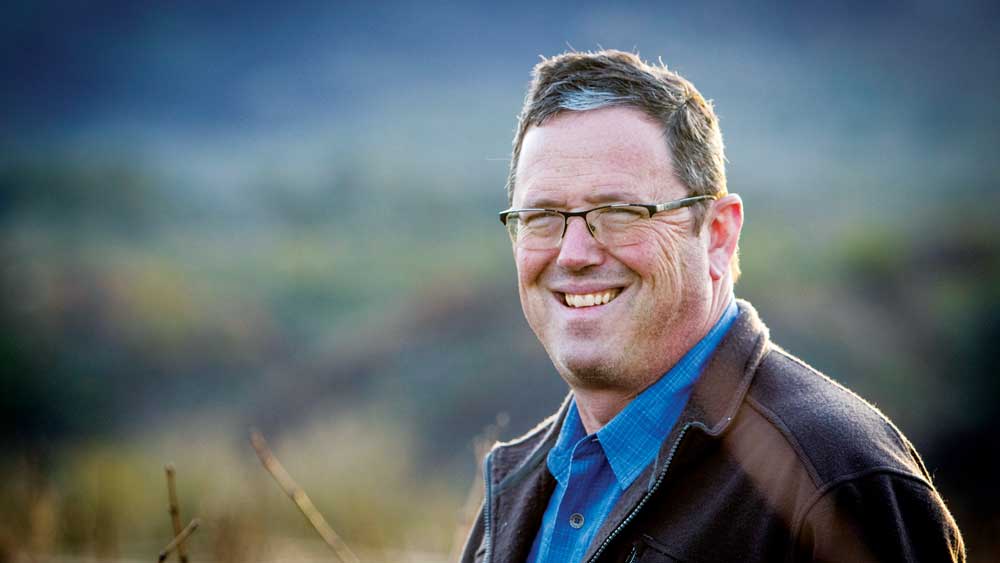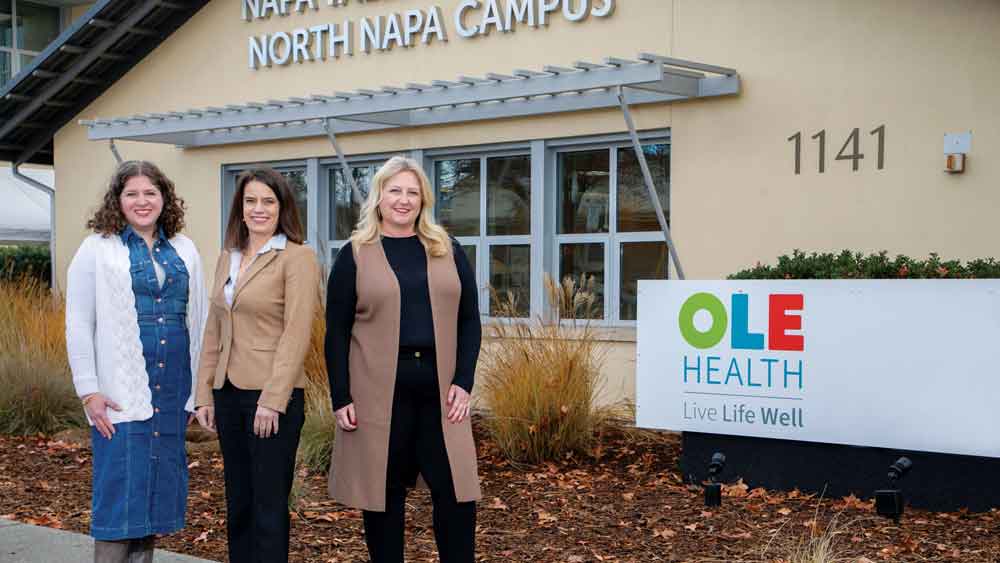
Great wine is ubiquitous in the heart of Napa Valley. But those fragrant aromas that permeate from a bottle of Chardonnay had some help along the way. There are countless farmworkers laboring in the vineyards, harvesting grapes from the vines and moving them along for the next steps in the winemaking process. These workers work exhausting, long hours to help their employers reach their goals each harvest season—sometimes braving the illnesses and injuries that can come through the physical demands of labor in the agriculture industry.
What is often overlooked is that far too many vineyard employees don’t have adequate health insurance. This is where OLE Health comes in.
Healthcare for all
OLE Health (pronounced: Oh-lay) was founded in 1972 as OLLE—the Organización Latino Americana de Liberación Economica—by a group of four farmworker advocates: Tala De Wynter, Placido Garcia, Aurelio Hurtado and Hope Lugo.
According to current OLE Health CEO Alicia Hardy, the organization was started by the four farmworkers because they wanted to ensure everyone had access to healthcare.
“There was previously no place for patients who didn’t have health insurance to receive care, so they really wanted to make sure there was healthcare for themselves and their families, and the community overall,” says Hardy. The first OLE Health center officially opened its doors in September 1972 in Rutherford. According to the organization’s website, precisely eight years from the day they first opened, a fire destroyed the Rutherford facility. But board members were quickly able to find a temporary home and within two weeks the clinic resumed services in a space loaned at the Yountville Veterans Home. Today, there are six OLE locations: Calistoga, East Fairfield, West Fairfield, North Napa, South Napa and St. Helena. There are a total of 353 employees working for OLE Health.
The organization’s mission is to build stronger communities by ensuring high-quality, comprehensive and personalized care for everyone who lives and works in the areas they call home. The doctors and staff are committed to helping care for their patients, regardless whether they’re insured, and this is what makes OLE so special. “I think that the employees at OLE Health are so committed to the mission that it is really kind of the heart and soul of what makes OLE Health so special,” says OLE Health Chief Development Officer Sonia Tolbert. “[It is] what has helped keep us being such an integral part of the community and making sure that everyone has healthcare for the last 50 years.”

Pete Richmond, president of Silverado Farming in Napa, is uniquely familiar with OLE Health; he has served as chair of OLE’s board of directors for about five years now. He says the role of the board is to represent the patients. In fact, he says, 51% of OLE’s board must be composed of patients, so as to ensure that patient care is a priority. He adds that the board advises the executive leadership team on the best practices and, in turn, the leadership bounces their own ideas off the board. He particularly likes that the board is made up of OLE clients—and that they’re a majority. Richmond says that being on OLE’s board is rewarding because of its mission and leadership team. “This one is really the most rewarding because of the intellectual brain trust of the leadership team and just the mission of the organization.”
OLE Health provides an array of services at all six of its clinics, including assistance with enrollment, family medicine, dental, pharmaceutical (there are two onsite pharmacies located at OLE’s North and South Napa campuses), behavioral health (including mental health), pediatrics, reproductive and sexual health, optometry and nutrition (including a health garden and teaching kitchen located at its South Napa Campus).
In addition to these services, Hardy says the organization also has mobile health and a robust outreach program as a way to reach out to people in neighboring communities who may otherwise not know about OLE Health.
“We go out into the communities and do both educational events as well as health screening fairs,” says Hardy. “So [we’re] trying to get people to engage and [obtain] care with us, and we do that across all the geographic areas that we serve for the outreach program.
She says they also offer “free food and veggie giveaways” in order to distribute regular fresh produce “across the different access areas.” She adds that OLE’s outreach specialists work with schools, other nonprofits and vintners; it’s with the latter that OLE will coordinate health fairs, since they employ many farmworkers. OLE will visit the job sites so the farmworkers can have their health screenings done without having to travel.
Individuals don’t need to meet specific criteria in order to become a patient at any of the OLE Health clinics. As Hardy explains, anyone who seeks medical treatment at OLE will not be turned away—it’s part of being a federally qualified health center. Instead, OLE offers a sliding fee scale for people who don’t have insurance. “We never ask about immigration status, but we do collect pay information,” says Hardy, adding that they’ll see clients from the higher end of an income level to those with no insurance at all. “Eighty percent of our patients are considered low-income and about 65% of patients are on Medi-Cal.”
Outreach is key
Tolbert praises the work of OLE’s two outreach support teams that are based in Napa County and in Solano County, of which the latter focuses more on the areas of Fairfield and Suisun City. The outreach teams work with a large network of community partners, as well as with local grocery stores—primarily those in Latino neighborhoods. Tolbert says outreach not only involves making important connections in communities, but ensuring those residents are aware of OLE’s two primary goals. “One, to make sure that people who don’t have insurance, but are eligible, are assisted in obtaining insurance, [thereby] reducing the number of uninsured people in our community,” says Tolbert. “And secondarily, for people who don’t have primary care [to know] that they can establish care with OLE Health.” She adds that OLE Health has certified Covered California counselors on staff, as well as its outreach teams who connect with people wherever they are—either buying groceries or connecting them with other community services like food banks, housing or schools. She says they’re making sure “no one is going to slip through the cracks” and help them to navigate what can be a pretty challenging healthcare landscape, especially for people who may not speak English or have other literacy challenges. But most of all, to know that OLE is there to help the under-insured. “If you don’t have health insurance, OLE Health can be your medical home. We take care of every single person, who walks through our door—regardless of their ability to pay, says Tolbert.”

OLE Health also partners with local food banks and other organizations—like Community Action Napa Valley—for its monthly food and veggie giveaway programs, which are distributed at its Calistoga, North Napa and Fairfield campuses on the third Friday of every month. For these giveaways, patients don’t need to meet a certain criteria in order to qualify, but the staff does document the number of patients who come by to pick up food. “We do ask a couple of questions to help us quantify the number of people who are needing the service and facing food insecurity,” says Tolbert.
OLE Health receives funding from a few different resources, including fundraising campaigns, the federal government, as well as from billing various insurances like Blue Cross, Cigna and Anthem. “We get a federal grant to help support our work because—again—our mandate is that we’re taking care of anyone regardless of ability to pay,” Tolbert says. Community grants and additional fundraising help round out their revenue streams. OLE’s primary annual fundraiser is called Vida OLE, a multi-day event held in May. Many of the OLE foundation’s board members host these events at their wineries and in their homes for people who want to support OLE. Also during Vida OLE, the organization holds an auction, private concerts and a high-end dinner.
Another thing Tolbert says she has seen while working with local businesses is an increase in OLE becoming a beneficiary of some cause-marketing initiatives, which she believes is an exciting way to look at how the organization diversifies its fundraising and adds different channels into the mix from traditional donations. OLE is also constantly working to bridge its funding gap. And in addition to a direct-mail campaign, the organization does a lot of work with donors. One particular donor event is called “Dinner with the Docs,” where OLE’s largest donors are invited to spend an evening and dine with the organization’s medical directors, giving donors an opportunity to connect with the people who are providing care for OLE’s patients.
The need for expansion
What is on the horizon for the future of OLE Health? Hardy says the organization is in the process of merging with another group of community health centers in Yolo County, which will double the amount of patients, OLE employees and its annual operating budget. She also says that OLE is looking to expand more in Fairfield. “We’re doing a couple of renovation projects in different cities to make sure that our health centers have as much capacity as needed,” Hardy says, citing their Calistoga center as “just too small” and the focus of a capital campaign to fund expansion.
“We’re opening a new site in American Canyon, which is the only city in Napa that we don’t have a physical presence and so that site is going to be opening hopefully in early 2023,” she adds.
Tolbert couldn’t agree more about needing another clinic in Napa County, especially since the demand there is high. Tolbert says OLE is the healthcare provider for one in three Calistoga residents, so to be able to expand the organization‘s facilities will be critical in meeting the rapidly increasing demand for its services.
“We enroll about 500 to 600 new patients a month and when you look at that on an exponential basis over the course of three years, that’s a lot of people that require more space, more exam rooms and more providers,” says Tolbert.
However, with its success come obstacles—like serving a region with a shortage of healthcare workers and a high-cost-of-living. “To support all of this, we’re also looking at some pretty aggressive workforce development programs, so that we can start to build a pipeline for healthcare workers,” says Tolbert. “It’s no secret that there’s a shortage of healthcare workers nationally. I think in Napa County, specifically, we have some added challenges…[such as] the cost of living that makes recruiting a little bit more challenging.”
She believes workforce development, investing in current staff, creating career opportunities for people to grow within the organization and the merger with the Yolo health centers will provide opportunities for that.
“And then we’re also actively working on a sustainability program so that we can help be a leader in reducing our carbon footprint, finding ways to be a lot more environmentally conscious and looking at how we can reduce waste and be more sustainable as an organization,” she adds.
In December 2022, OLE launched its Mobile Health Initiative, which is basically an exam room on wheels. OLE will take it out to farmworker housing facilities in Napa County—similar to how the organization originally started 50 years ago—and will make sure all of the migrant
farmworkers will receive the proper health care they need.
Into the future
As for where OLE Health would like to be in 10 years, Hardy says she hopes that OLE can continue to add more services and create better access to specialty services for its patients. She adds that within the next couple of years, as the state transitions into a different payment model, it will allow OLE more flexibility in how it take care of its patients. “Once those changes have been made, we can redesign our care model to have a full array of services that really looks at the [socio-economic] drivers,” says Hardy. “But when you look at some of our patients’ needs… access to some basic resources are really high [priorities] for our patients.
“The more that we can add and do under our own roof is going to be beneficial to our patients and making sure we get them those services.”
Echoing the same sentiments, Tolbert says OLE Health’s goal is to be as much of a one-stop shop for patients as possible, including determining what specialty services it can provide. OLE is committed to helping patients navigate other life challenges, what Tolbert refers to as “social determinants of health”—such as housing, clothing, food and safety. “You’re not going to be thinking about coming in for your annual exams if you’re struggling to put food on your table,” she says. It’s all part of OLE’s belief in preventative care—helping people live healthy lives, as opposed to only taking advantage of OLE services when they’re sick.
Board chair Richmond personally attests that OLE Health is a great place to go for your medical needs, saying that after having had a private primary care physician, he switched his healthcare to OLE because he wanted to have the same experience as patients. He’s found it’s just as good as any other health care he’s had before. “I think we have to get away from the concept that this is a health care center for the poor; that it’s marginal care,” says Richmond. “If you tour our facilities, they’re better than most doctors’ offices.”
Adds Richmond: “[Our] doctors have been here for years and are very patient-driven. We’re really trying to get the general public to understand that this is a great place to go for anyone who wants to get health care.”
As for the positive impact OLE Health is making, Richmond—whose business employs farmworkers from Mexico and Central America—says his employees’ ability to access health care through OLE is unique. “The fact that folks who have never had health care, now have access to essentially the same health care that I would have from my employer, is pretty astonishing.” n



